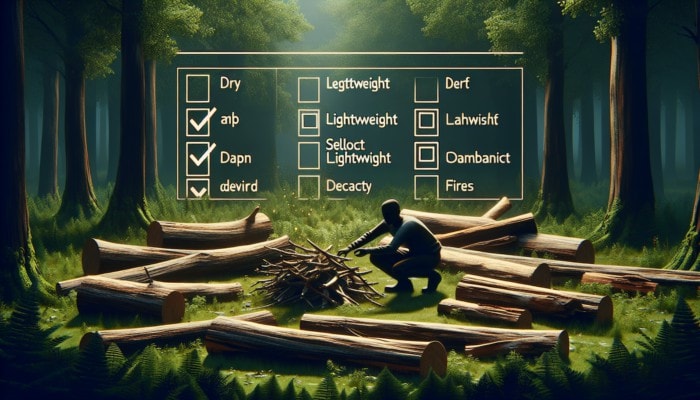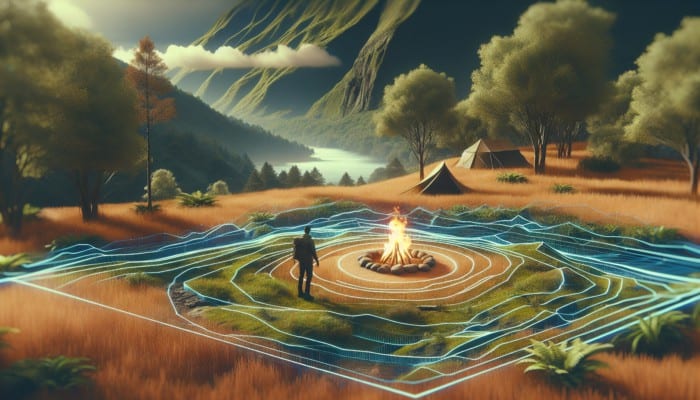Selecting the Optimal Location for Effective Fire-Making in the Wilderness
Identifying the most suitable location for fire-making in the wild is crucial to the success of your endeavour. A well-chosen spot enhances safety and enriches your overall experience as you immerse yourself in nature. When you venture into the wilderness, it is essential to understand the various elements at play while thoroughly assessing your immediate surroundings for potential hazards and benefits.
Evaluating Wind Patterns and Weather Conditions

The direction of the wind plays a pivotal role in ensuring the safety and efficiency of your fire. Before igniting your fire, take a moment to observe the prevailing winds within the area. Positioning your fire downwind from your intended activities—such as cooking or socialising—will help keep smoke out of your eyes and maintain a more enjoyable atmosphere for all involved. Additionally, it is wise to consider the forecast: if rain is on the horizon, select a sheltered location to protect your fire from being extinguished by unexpected moisture. Seek out natural windbreaks, such as large boulders or dense clusters of trees, to help minimise airflow.
On a more technical level, comprehending local weather conditions can significantly assist you in fire-making. Areas known for sudden shifts in weather might necessitate contingency plans, such as the ability to shield your fire or extinguish it quickly if conditions deteriorate. Trust your instincts and always prioritise safety over mere convenience when deciding on a location for your fire.
Identifying Elevated, Dry Ground for Optimal Fire Performance
The performance of your fire is largely dependent on the ground beneath it. Elevated and arid spots are ideal as they ensure that your fire remains lit and is less vulnerable to rain or moisture. Search for areas not recently submerged or saturated by rainfall—hilltops and ridges are often excellent options. Wet ground absorbs heat and moisture, snuffing out your flames before flourishing.
Additionally, consider the material of the surface underfoot. Leaf litter or dry grass can catch fire rapidly but may burn too quickly, creating an unstable fire. Instead, opt for rocky or sandy surfaces that allow your fire to breathe while providing stability. As you examine the terrain, look for natural barriers that can help contain your fire, preventing it from spreading uncontrollably and ensuring a safer experience for everyone.
Establishing a Safe Perimeter Around Your Fire
Creating a secure fire area involves more than merely selecting the right ground. A vital step is to eliminate any flammable materials within a reasonable radius. This includes clearing away dry leaves, twigs, and other combustible debris that could easily ignite and lead to a dangerous situation. Aim for a minimum distance of at least three feet around your fire site to ensure ample space for smoke to disperse and for people to gather safely without the risk of accidental burns or fires.
Furthermore, consider the proximity of your fire to nearby structures or trees. A well-established fire should never be within striking distance of overhanging branches or tents. The key to a successful fire-making experience lies in being proactive about safety; taking these precautions lays the groundwork for a delightful evening under the stars, free from concerns about your fire's potential to spread uncontrollably.
Collecting Essential Materials for Effective Fire-Making in the Wilderness

No fire can thrive without the appropriate materials, and understanding how to gather these essentials is fundamental for anyone wishing to master fire-making in the wild. The process begins with the smallest components and gradually builds up to larger fuel sources, with each step being critical to achieving a robust fire capable of withstanding the elements.
Choosing the Best Tinder for Efficient Ignition
Tinder serves as the spark that ignites your fire, making selecting the right materials paramount. Optimal tinder includes dry leaves, grass, or birch bark, which readily catches sparks and ignites quickly. Birch bark is particularly advantageous due to its natural oils, which facilitate ignition even in damp conditions.
As you gather tinder, focus on ensuring the materials are completely dry and moisture-free. A good test is to crumple the leaves or grass; if they break easily, they are suitable for use. Avoid collecting green or damp materials, as these will only hinder your fire's ability to spark. When in doubt, search for dead plants or fallen tree bark, which often provide excellent sources of tinder.
Another effective strategy is to carry pre-prepared tinder in your gear. For instance, cotton balls dipped in petroleum jelly create outstanding fire starters that ignite easily and burn long enough to catch larger kindling, making your fire-making efforts significantly easier.
Gathering Quality Kindling for Fire Transition
Once you've acquired suitable tinder, the next step involves gathering kindling. This consists of small, dry sticks and twigs facilitating the transition from tinder to larger logs. As you explore your surroundings, look for dead branches on the ground that can be easily snapped, as these will work effectively as kindling.
When collecting kindling, opt for materials that are approximately the thickness of a pencil. This size allows for rapid ignition and burning, providing the necessary heat to ignite larger fuel sources. Layering your kindling in a crisscross pattern can enhance airflow, allowing the flames to grow more robustly as they transition to larger logs.
Remember, variety is essential. Collect kindling in different sizes to create a robust fire structure. Combining thinner twigs with slightly thicker sticks ensures a steady progression in fire strength and longevity, ultimately enhancing your experience of fire-making in the wild.
Locating Suitable Firewood for Sustained Heat

The final segment of material gathering involves acquiring firewood. Larger, dry logs are essential for sustaining your fire once it is established. When searching for firewood, concentrate on downed trees or branches that are not in direct contact with the ground, as these are more likely to be dry.
Select lightweight logs and produce a crisp sound when struck together. This indicates they are dry and suitable for burning. Additionally, check for signs of rot or dampness; a log that feels heavy or has a spongy texture will yield minimal heat and produce excessive smoke, which could ruin your fire-making experience.
As you gather firewood, consider your fire's anticipated duration. If you plan to be out for an extended period, collect more firewood than you need. Building an abundant supply allows you to maintain a consistent fire that provides warmth and light throughout your time in the wild, ensuring a comfortable and enjoyable experience.
Mastering Fire-Starting Techniques for Wilderness Fire-Making
Mastering various fire-starting techniques is pivotal for your fire-making arsenal. Whether you face challenging weather conditions or simply wish to impress your companions with your skills, knowing multiple methods ensures you can adapt and succeed in fire-making in the wild.
Utilising a Reliable Firestarter for Convenient Ignition
The most straightforward and dependable method for fire-making in the wild is employing a firestarter, such as a lighter or matches. This technique is especially beneficial in wet or windy conditions, where traditional methods may falter. When using a lighter, aim for one that is windproof, particularly if you anticipate breezy environments that could complicate your efforts.
An important aspect of using a firestarter is understanding how to prepare your materials beforehand. Ensure your tinder is well arranged to allow easy access to flames. Light the tinder and watch as it ignites, sending flames upwards to catch the kindling. Always keep a backup firestarter, such as waterproof matches, to ensure you are never caught unprepared in the wilderness.
While firestarters are immensely convenient, they can also be valuable learning tools. Take time to practice different techniques with your firestarter, adjusting how you position the materials until you find the best method. This skill can make or break your fire-making efforts, especially in challenging conditions where every second counts.
Implementing the Flint and Steel Method for Traditional Fire Starting
For those adventurous enough to embrace traditional techniques, the flint and steel method provides a reliable option for fire-making in the wild. By striking flint against steel, you generate sparks capable of igniting your carefully prepared tinder. Understanding the science behind this method can dramatically increase your chances of success and enhance your outdoor skills.
When employing this method, ensure your flint is high-quality and your steel is sharp. Proper technique is paramount; strike the flint at a sharp angle to produce the best sparks. Position your tinder close to the point of impact to catch the sparks quickly, resulting in a successful ignition.
This method is particularly advantageous in wet conditions where matches may fail. The sparks generated by flint and steel can often ignite damp tinder that would otherwise be unresponsive to flame. Practising this technique not only enhances your survival skills but also adds an element of excitement and challenge to your fire-making experience.
Exploring Friction-Based Fire-Starting Techniques
While challenging, friction-based fire starting is a rewarding skill for anyone venturing into the wild. Techniques such as the bow or hand drill require practice and patience, making them ideal skills to learn before encountering a survival situation.
The bow drill method involves creating a notch in a flat piece of wood, using a spindle and bow to generate friction and heat. This process requires precise movements and a consistent rhythm, as the friction generates a small ember that can then be transferred to your tinder for ignition.
While mastering friction-based methods, it is crucial to consider the type of wood used; softer woods often ignite more effectively than harder varieties. Regular practice is essential to develop muscle memory and increase your chances of success. In addition to being a valuable skill, it can serve as an impressive party trick among fellow adventurers, showcasing your resourcefulness and ingenuity.
Constructing Your Fire for Optimal Fire-Making in the Wild
Effectively constructing your fire is vital for achieving a steady, long-lasting flame. Different fire-building techniques offer unique advantages and can be adapted based on the conditions you encounter. Understanding how to assemble your fire will elevate your fire-making in the wild experience, making it more enjoyable and efficient.
Creating a Teepee Structure for Maximum Airflow
The teepee structure is one of the most popular fire-building methods, and for good reason. By arranging kindling in a teepee shape around your tinder, you create ample airflow, encouraging the flames to grow rapidly and efficiently. The open design allows heat to circulate, vital for igniting larger logs and sustaining a robust fire.
Begin by placing your tinder in the centre, then arrange the kindling around it, leaning the pieces against each other to form a cone. Ensure the kindling is not packed too tightly; sufficient airflow is essential for sustaining the fire. As the tinder ignites and embers form, the kindling will catch fire and generate heat, paving the way for larger firewood to ignite.
This structure is particularly effective in dry weather, allowing for a quick start. However, in windy situations, the teepee may require modification to prevent it from collapsing. Consider reinforcing it by using larger logs around the base to stabilise the structure and protect it from being blown over by wind gusts.
Utilising the Log Cabin Method for a Stable and Long-Lasting Fire
The log cabin method is an excellent choice for those seeking a stable and enduring fire. Stacking logs in a square, cabin-like formation creates a solid structure that can withstand wind and provide sustained heat. This configuration is ideal for longer camping trips or gatherings around the fire.
To construct a log cabin fire, start with a small tinder base and kindling. Once the tinder is lit, gradually stack larger logs around the kindling in a square shape. Ensure the logs are not tightly packed, allowing airflow to feed the flames. The log cabin design is visually appealing and maintains a steady burn, keeping the fire alive through the night and providing a comforting glow.
As you build your log cabin, consider the size of your logs. Opt for a mix of smaller and larger logs to ensure the fire has a steady fuel source. This method creates a warm and inviting atmosphere, ideal for storytelling and bonding with fellow campers under the stars.
Implementing the Lean-To Configuration for Versatility
The lean-to configuration is a versatile fire-building method, especially in windy conditions. By placing a larger log as a windbreak, you can lean smaller sticks against it, creating a shelter for your fire. This technique is particularly beneficial when protecting your flames from adverse weather while ensuring adequate airflow for combustion.
To construct a lean-to fire, start with your windbreak log at a 45-degree angle to the prevailing winds. Next, place your tinder and kindling at the base, leaning smaller sticks against the windbreak log. This structure not only shelters the fire from wind but also directs heat towards your gathered fuel, helping to maintain warmth and ensuring a steady burn.
Efficiency is key when utilising this method. Be mindful of the height of your lean-to; if it's too short, the flames may not reach the kindling effectively. Adjusting the angle of the windbreak log can also enhance your fire's performance by optimising airflow and keeping the fire burning steadily, allowing you to enjoy your time outdoors fully.
Utilising the Top-Down Fire Lay for Reduced Maintenance
The top-down fire lay is an innovative method that allows for a longer-lasting burn while requiring less maintenance. By starting with larger logs at the bottom and placing smaller logs and kindling on top, you create a fire that ignites from the top down. This approach is particularly effective for seasoned campers seeking a hassle-free fire-making experience.
To build a top-down fire lay, arrange your largest logs in a square shape, followed by a layer of medium-sized logs. Finally, place your tinder and kindling on top, ensuring they can easily catch fire. As the fire burns downwards, it gradually ignites the layers beneath, providing sustained heat and minimal need for constant attention.
This technique is efficient and reduces smoke production, making it ideal for camping in areas sensitive to fire regulations. Embracing this method in your fire-making repertoire will simplify the process and enhance your outdoor adventures, allowing you to focus on enjoying nature rather than constantly tending to the fire.
Effective Fire Maintenance for Wilderness Fire-Making
Once your fire is roaring, effective maintenance becomes crucial for ensuring a steady burn and maintaining a safe environment. Understanding how to manage your fire enhances your experience and keeps you and others safe while enjoying the beauty of fire-making in the wild.
Gradually Adding Fuel for Sustained Flame
One key to maintaining an intense fire is the gradual addition of fuel. Feeding your fire slowly, you avoid smothering the flames and maintain a steady heat output. Start with smaller logs and increase to larger ones only after the fire has established itself and is robust.
Monitor your fire and assess the amount of heat and light it generates. If the flames wane, carefully add more wood while ensuring proper airflow. Avoid tossing large logs onto the fire all at once, as this can disrupt the flames and lead to a suffocating fire that fails to thrive. Instead, consider a measured approach, allowing the fire to grow naturally and maintain its intensity.
In high-wind conditions, adapt your strategy by being more cautious with the amount and type of fuel you add. Larger logs may extinguish flames if added hastily, so remain vigilant and watch the fire's behaviour closely. This proactive approach ensures a consistent and enjoyable fire experience throughout your camping trip, allowing you to relax and soak in the surrounding beauty.
Adjusting Airflow for Optimal Fire Intensity
Airflow plays a vital role in the intensity of your fire. A well-oxygenated fire burns hotter and more efficiently, while a lack of air can lead to excessive smoke and weak flames. Adjusting the arrangement of your logs is an effective method for controlling airflow and fire intensity.
If your fire appears sluggish or produces excessive smoke, consider repositioning the logs to create more space for oxygen to enter. This can be accomplished by gently shifting the logs or adding strategically placed kindling to create channels for airflow. Conversely, if the fire is burning too hot and rapidly, you can close off airflow slightly by rearranging the logs closer together to maintain a balanced burn.
Understanding how to manage airflow effectively will lead to a more enjoyable fire-making experience. This will allow you to fully embrace the beauty of the wilderness while staying warm and safe amidst nature's wonders.
Prioritising Fire Safety for an Enjoyable Experience
Maintaining a safe fire environment is paramount for all outdoor enthusiasts. Regularly monitoring your fire and surroundings will help prevent it from spreading and ensure it remains contained and manageable.
Always keep a bucket of water or sand nearby to address any unexpected flare-ups swiftly. Be vigilant about the direction of the wind and its impact on the fire. If you notice sparks flying or flames licking higher than expected, it may be time to adjust your setup or extinguish the fire entirely to prevent any potential hazards.
Additionally, establish a perimeter around your fire to keep it safe from others. Encourage guests to stay a safe distance away and never leave the fire unattended, especially if children or pets are present. Your dedication to fire safety will ultimately enhance everyone’s experience, allowing you to enjoy the warmth and light of your fire without unnecessary worry or concern.
Properly Extinguishing the Fire After Wilderness Fire-Making
Properly extinguishing your fire is just as important as starting and maintaining it. Leaving a fire unattended or failing to extinguish it fully can lead to wildfires and other hazards that threaten the environment and its inhabitants. Understanding the best techniques for putting out your fire ensures that you leave the environment as you found it, making it safe for future visitors and preserving the natural beauty of the wilderness.
Effective Dousing with Water Technique
Dousing it with water is one of the most effective methods for extinguishing a campfire. Pour water over the flames until they are completely extinguished, and then stir the ashes with a stick to ensure no embers remain. This process is crucial, as hidden embers can reignite if left untreated, posing a fire risk.
When pouring water, do so slowly and carefully to avoid creating steam, which can cause burns. Make sure to saturate all materials in the fire pit, as any remaining dry wood can easily reignite, leading to potential hazards.
After extinguishing your fire, it’s essential to inspect the area again to ensure everything is cool to the touch before leaving. Adopting this practice will help prevent potential wildfires and maintain the integrity of the wilderness around you, ensuring a safe and responsible outdoor experience.
Smothering the Fire with Dirt for Quick Extinguishment
Another effective fire extinguisher technique is smothering it with dirt or sand. This method removes the oxygen supply, ensuring the flames die out completely. This technique is particularly beneficial in areas where water may be scarce or when you want to avoid excess smoke that could affect the surrounding environment.
To use this method, carefully scoop dirt or sand over the fire, completely covering all embers and materials. Ensure the fire is fully covered, as any exposed hotspots can reignite when conditions are favourable, posing a risk to the surrounding area.
Like the water method, after smothering the fire, always check the ashes to confirm they are cool before leaving the site. This additional step is critical in preventing unintentional wildfires and demonstrating respect for the environment and its preservation.
Conducting a Heat Check After Extinguishing the Fire
After extinguishing your fire, checking for residual heat is essential to ensure it is completely out. Carefully touch the ashes with your fingers; if they feel warm, the fire might not be fully extinguished and could reignite if left unattended.
Continue to douse or smother any remaining heat until everything is cool. This final check ensures that the fire does not reignite, prioritising safety for the environment and future visitors who may use the same area.
Always remember, taking these precautions not only protects the wilderness but enhances your experience, allowing you to leave without the worry of any lingering embers that could threaten the natural surroundings.
Utilising a Fire Extinguisher for Added Safety
While less common in outdoor settings, having a fire extinguisher on hand can be incredibly beneficial, especially in high-risk areas or during dry seasons when fire dangers are elevated. To use a fire extinguisher effectively, aim the nozzle at the base of the fire and squeeze the handle. Sweep the nozzle from side to side until the flames are completely extinguished, ensuring thorough coverage.
This method provides an added layer of safety and assurance, particularly when camping with groups or in areas where fire safety regulations are stringent. Familiarity with your fire extinguisher and practicing its use can prepare you for unexpected situations that may arise during your outdoor adventures.
In summary, while fire-making is a cherished skill in the wild, it also comes with responsibility. Ensuring your fire is safely extinguished protects the environment and your fellow adventurers, allowing everyone to enjoy the beauty of nature without fear of fire-related hazards.
Environmental Considerations When Practising Fire-Making in the Wilderness
As enriching as fire-making in the wild can be, it is equally essential to consider the environmental impact of your activities. Responsible fire-making techniques ensure that the wilderness remains pristine and enjoyable for future generations, promoting a sustainable outdoor culture.
Minimising Environmental Impact During Fire-Making
Selecting a fire site that minimises environmental damage is paramount to responsible outdoor ethics. Whenever possible, utilise existing fire rings or established fire pits to reduce impact on the surrounding flora and fauna, helping preserve the natural landscape for future visitors.
When choosing a location, consider sensitive ecosystems and avoid areas abundant with wildlife or rare plants. Designating a sustainable fire site preserves natural habitats and ensures that your fire-making activities align with Leave No Trace principles, contributing to the conservation of nature.
Additionally, consider the materials you use for your fire. Whenever feasible, opt for firewood sourced from dead and downed timber rather than cutting down live trees. This practice maintains the integrity of the ecosystem while providing ample fuel for your fire, ensuring that your outdoor activities have a minimal ecological footprint.
Respecting Local Fire Regulations and Guidelines
Fire regulations vary widely depending on where you are camping, making it crucial to research local laws and guidelines before lighting a fire. Many national parks and forests have specific regulations to safeguard against wildfires and protect the delicate balance of wildlife and vegetation.
Understanding fire restrictions may involve checking weather conditions or obtaining necessary permits in certain areas. Respecting these regulations not only helps you avoid fines but also contributes to preserving the natural environment and the safety of all visitors.
Always stay informed of fire bans or restrictions, particularly during dry seasons when fire risks are elevated. Your commitment to adhering to these guidelines ensures that you enjoy a safe and responsible fire-making experience while minimising the potential for environmental harm.
Practising Proper Waste Disposal for Environmental Care
Proper waste disposal plays a critical role in maintaining the beauty of our wilderness areas. When camping, ensure you pack out all trash and leftover materials, including food scraps and non-biodegradable items. This commitment to cleanliness preserves the landscape's natural beauty and protects wildlife from harmful interactions with human waste.
Utilising designated bins when available and adhering to Leave No Trace principles helps protect wildlife and ensures a clean environment for future visitors. Ensure that any remnants of your fire are also disposed of correctly, removing any unburned materials or ashes from your campsite to leave the area as you found it.
Taking these steps contributes to preserving nature, allowing others to enjoy the beauty of wild spaces without the burden of litter or environmental degradation. Committing to responsible practices enhances your outdoor adventures while respecting the delicate balance of nature and its ecosystems.
Frequently Asked Questions About Fire-Making in the Wilderness
What is the best method to start a fire in wet conditions?
The most effective way to start a fire in wet conditions is to use a firestarter, such as waterproof matches or a reliable lighter, along with dry tinder like birch bark. This ensures a successful ignition.
How can I tell if wood is dry enough to burn?
Dry wood will produce a hollow sound when struck together and feel light in weight. If it is damp or feels heavy, it likely won't burn effectively, making it unsuitable for your fire.
What is the safest method to extinguish a fire?
The safest way to extinguish a fire is to douse it with water until it is completely out, stirring the ashes to ensure that no embers remain, thereby preventing potential hazards.
Is it advisable to use green wood for fire-making?
Green wood is not recommended as it contains moisture that hinders combustion and produces excessive smoke. Always opt for dry wood to ensure effective burning and a cleaner fire.
How do I build a fire in windy conditions?
To build a fire in windy conditions, use a lean-to configuration for wind protection and arrange your kindling to allow for good airflow. This will enhance your fire's stability and performance.
What materials are best suited for tinder?
Dry leaves, grass, and birch bark are ideal tinder materials. These materials catch sparks easily and ignite quickly, making them excellent choices for starting a fire.
How far away should I set up my fire from my tent?
Setting up your fire at least 10 feet away from your tent is recommended to prevent heat damage and reduce the risk of fire spreading, ensuring a safe camping experience.
Is it necessary to check with local regulations before making a fire?
Yes, always check local regulations regarding fire-making. Many areas have specific rules or bans in place to prevent wildfires, protect wildlife, and ensure responsible outdoor behaviour.
What should I do if my fire starts to spread?
If your fire starts to spread, immediately douse it with water or smother it with dirt, and use a shovel or stick to break apart the burning materials to prevent further spread and ensure safety.
Can I leave my fire unattended for a short while?
It is not advisable to leave your fire unattended at any time. Always ensure it is fully extinguished before stepping away, prioritising safety for yourself and others in the area.
Explore our world on X!
Survival Poncho Guide: Essential Tips for All Climates
Selecting the Perfect Survival Poncho for Your Needs Understanding Materials and Ensuring Durability Survival Poncho Guide: When choosing the right material for your survival poncho, consider both longevity and effectiveness in challenging situations. Survival ponchos are typically made from a range of materials, such as nylon, polyester, and PVC, each offering distinct levels of durability and waterproofing. […]
Wilderness Fire Safety: Essential Tips and Techniques
Mastering Wilderness Fire Safety Fundamentals What Are the Primary Sources of Wilderness Fires? Wilderness Fire Safety: Wilderness fires can ignite from numerous sources, which are mainly divided into natural and human-induced factors. Among natural causes, lightning strikes are particularly notorious for igniting dry vegetation, especially in remote, arid regions. Under optimal weather conditions, these fires […]
Survival Compass Guide: Essential Tips for Navigation
Mastering Compass Navigation: Essential Knowledge and Techniques What is a Compass and Its Importance? Survival Compass Guide: A compass is an indispensable navigational tool that enables individuals to ascertain direction in relation to the Earth's magnetic poles. This device typically features a magnetised needle that consistently points towards magnetic north, facilitating orientation in unfamiliar terrains. […]
SHTF Hunting Skills: Essential Techniques for Survival
Mastering the Essentials of SHTF Hunting Gaining Insight into Prey Behaviour for Success SHTF Hunting Skills: Understanding the habits and patterns of various animals is fundamental to increasing your chances of a successful hunt. This knowledge is not merely beneficial but essential for survival in any environment, particularly during an SHTF scenario where food sources […]








This is such a practical guide—location really does make or break the fire-making experience! I’ve had my fair share of smoky evenings when I neglected the wind direction. Once, I set up my fire pit downwind from my tent, and let’s just say my attempts at s’mores weren’t as enjoyable with all that smoke in my face!
Ah, the fine art of fire-making in the wild! It really is an essential skill, but I sometimes wonder if it has less to do with safety and more to do with channeling our inner caveman as we huddle around the flames, swapping stories and semi-burnt marshmallows.
Your insights on the importance of selecting the optimal location for fire-making in the wilderness truly resonate with my experiences in outdoor settings. Fire undoubtedly serves as one of the most vital components of any wilderness adventure—providing warmth, enabling cooking, and creating a sense of comfort. Your emphasis on evaluating wind patterns and weather conditions before igniting a fire is particularly relevant.
This piece on selecting the optimal location for fire-making truly resonates with me, especially as someone who has spent quite a bit of time in the great outdoors. Your emphasis on the importance of evaluating wind patterns and weather conditions is spot-on. I remember a camping trip where I ignorantly set up our firepit in a small clearing that seemed perfect at first. However, as night fell, the wind picked up and blew smoke directly into our area, turning what should have been a cozy evening around the fire into an uncomfortable ordeal. It was a hard lesson learned about the significance of positioning.
Selecting the right spot for fire-making indeed sets the stage for a myriad of experiences in the wilderness. I remember my first solo camping trip, where I underestimated the impact of wind patterns. I built my fire on a slight incline, thinking it would be cozy; however, I soon found myself battling both smoke and an erratic flame that flickered unpredictably. It reinforced for me how vital it is to understand your surroundings—not just for the fire itself but also for the overall safety and enjoyment of the outdoors.
Your experience really highlights an important aspect of outdoor activities that many overlook, especially beginners. Fire-making isn’t just about having the right tinder and kindling; it’s heavily influenced by the environment around you. Wind patterns can shift quickly, and the position of your fire can turn what should be a peaceful evening into a frustrating battle with smoke and erratic flames.
“Your experience truly highlights the importance of location when it comes to fire-making! If you’re looking to enhance your outdoor skills even further, check out this resource for tips on mastering fire safety and technique.”
https://survivalbite.com/wild
Your experience perfectly illustrates how fire-making can be influenced by the environment, and it’s fascinating to hear about it. The way wind patterns can shift not only the direction of smoke but also how a fire burns is something that often goes overlooked. I’ve seen many campers, including myself at times, fail to account for simple elements like incline and prevailing winds, thinking they understand the dynamics of a flame.
“Your experience really highlights the importance of choosing the right spot! For more tips on mastering fire safety and enhancing your outdoor adventures, check out this helpful guide.”
https://survivalbite.com/LostFoods
This discussion on selecting the right fire-making spot resonates deeply with my experiences in the wilderness. I remember a camping trip where we underestimated the wind and ended up with smoke swirling right into our cooking area—definitely not the cozy experience we were looking for! It’s a great reminder of how nature’s elements can dramatically affect our enjoyment and safety.
This post resonates deeply with me as I reflect on my own wilderness experiences. Selecting the right location for fire-making isn’t just a matter of convenience; it forms the foundation for the entire camping experience. I remember one particular trip where I underestimated the wind patterns. I had positioned my fire in a charming clearing, only to find that it was directly downwind from our cooking area. Not only did the smoke cause discomfort, but it also made cooking more challenging than it needed to be. This post serves as a valuable reminder of how crucial it is to assess our environment before igniting a flame.
This is such an important topic! I can’t emphasize enough how crucial the right fire-making location is when you’re out in the wild. A couple of years back, I went on a camping trip in the Rockies, and this very principle saved our experience from turning into a smoky ordeal. We made sure to set up our fire within a sheltered area, paying close attention to the wind direction, which was especially noticeable on the ridge we were camping on. Not only did this keep the smoke away from our cooking area, but it also created a surprisingly cozy ambiance for our evening socializing, with the fire at our backs providing warmth and light against the darkening forest.
You’ve struck a very important chord here with the topic of fire-making locations in the wild; it’s something many overlook but has such a significant impact on the whole camping experience. I remember my first solo camping trip in the Pacific Northwest, where I naively just picked a spot because it seemed nice and scenic, without considering the wind patterns. Let’s just say my cooking experience was overshadowed by smoke swirling right into my eyes, and I ended up with a face-full of ash instead of enjoying a cozy campfire dinner.
This topic on fire-making location resonates deeply with me, as finding the right spot to ignite a fire is akin to finding sanctuary within nature itself. I recall a memorable camping trip where I spent hours scouting the perfect site at dusk. It was a lesson in patience and attentiveness, but the rewards were immeasurable. I decided to set up my fire pit on a slight incline, sheltered from the wind but still granting me a glimpse of the sunset while ensuring that my cooking activities stayed well clear of the smoke.
Finding that perfect spot for a fire really does reflect a deeper connection to the outdoors, doesn’t it? Your experience with scouting the ideal location at dusk emphasizes how crucial it is to be present in the moment. It’s more than just picking a place; it’s about understanding the environment and what it offers.
This is such an essential topic! I remember my first camping trip, where I learned the hard way how crucial wind direction can be. We set up our firepit without much thought to the breeze, and it quickly turned into a smoke-filled nightmare. It made me realize how respecting nature’s patterns not only enhances safety but also elevates the experience.
Your insights about selecting the right location for fire-making resonate deeply with my own experiences in the wilderness. I remember a camping trip where I failed to take wind patterns into account; I had positioned my fire too close to our cooking area, and the smoke quickly became an overwhelming nuisance. It not only affected my enjoyment of the meal but also impacted the overall experience for the group. Since then, I’ve made it a point to carefully assess my surroundings before lighting a fire, ensuring that I’m downwind and cognizant of the potential hazards.
Your experience really highlights an important point about fire-making in the wilderness. It’s fascinating how an element as fundamental as fire can turn a pleasant time into a frustrating memory if not managed properly. The wind and smoke factor can often be an afterthought, but as you’ve discovered, it plays a significant role in both enjoyment and safety.
“I’m glad to hear your experiences align with the importance of location! If you’re looking for more tips on fire safety and outdoor cooking, check out this resource that dives deeper into the topic.”
https://survivalbite.com/LostFoods